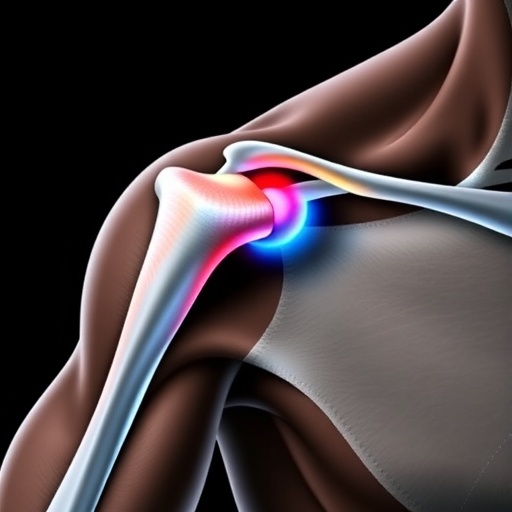
Recent research has illuminated a substantial breakthrough in the treatment of non-small cell lung cancer (NSCLC) through the incorporation of Qingrehuoxue formula into standard anti-PD-1 immunotherapy. This combination has demonstrated a remarkable ability to enhance patient outcomes by effectively remodeling the tumor immune microenvironment, a critical component in cancer progression and immune evasion. The study, spearheaded by Li et al., has shed light on the intricate mechanisms involved, particularly focusing on TREM2 signaling pathways, which are pivotal in modulating immune cell activities and tumor interactions.
The importance of the immune microenvironment cannot be overstated when it comes to cancer therapy efficacy. Tumors are not merely collections of cancer cells; they are complex ecosystems composed of various cell types, including immune cells, stromal cells, and the extracellular matrix. These components interact closely, often leading to an immunosuppressive environment that enables tumor proliferation and metastasis. Traditional therapies, including anti-PD-1 drugs, often face challenges because of this hostile milieu. The innovative findings from this study provide hope that strategies to alter this environment can significantly improve therapeutic responses.
The Qingrehuoxue formula, a composite traditional Chinese medicine, has long been utilized for its purported health benefits, particularly in enhancing blood circulation and boosting immunity. However, its specific effects on the tumor immune landscape were previously underexplored. In this groundbreaking study, the researchers meticulously observed the formulation’s capability to not only improve immune function but also directly impact TREM2 signaling pathways, which play a crucial role in regulating immune responses within tumor settings.
TREM2, or Triggering Receptor Expressed on Myeloid Cells 2, is a receptor of great interest in oncology due to its involvement in the regulation of macrophage activation and polarization. It has been shown that TREM2 can contribute to an anti-inflammatory, immunosuppressive phenotype when activated, facilitating tumor cells’ evasion of immune surveillance. By targeting this pathway, the Qingrehuoxue formula effectively reprograms tumor-associated macrophages, creating an environment less conducive to tumor growth and more favorable for immune attack.
One of the study’s most compelling findings is the synergistic effect observed when the Qingrehuoxue formula is combined with anti-PD-1 therapy. The combined treatment not only improved the immune response against tumor cells but also enhanced the overall effectiveness of the PD-1 blockade. Patients receiving this dual regimen exhibited significant reductions in tumor size and improved survival rates compared to those receiving anti-PD-1 therapy alone. Such results underscore the potential for integrated treatment modalities that leverage both traditional and modern therapeutic approaches.
In a detailed analysis, the researchers utilized a variety of laboratory models, including in vitro assays and in vivo animal studies, to evaluate the efficacy of the combined therapies. These models provided a comprehensive understanding of the biological mechanisms at play, demonstrating that the Qingrehuoxue formula not only boosts immune cell activation but also alters the tumor’s metabolic landscape, making it less hospitable to cancer growth. The research highlights a critical step forward in the quest for more effective cancer treatments, particularly for diseases characterized by complex immune evasion strategies.
The study’s methodology was rigorous, employing cutting-edge technologies such as flow cytometry and immunohistochemistry to assess immune cell populations and their functional states. By evaluating the dynamics of immune cell infiltration within tumors, the researchers were able to discern how the Qingrehuoxue formula shifted the balance of immune cells from a predominance of tumor-supportive to pro-inflammatory phenotypes. This shift was crucial in restoring the effectiveness of PD-1 inhibitors.
Furthermore, the research findings advocate for a more nuanced understanding of personalized medicine in cancer treatment. The results suggest that incorporating the Qingrehuoxue formula into standard treatment regimens could be particularly advantageous for subsets of patients with NSCLC harboring specific immune characteristics. This understanding allows for more tailored therapies, maximizing efficacy while minimizing potentially harmful side effects associated with conventional cancer treatments.
As the study progresses toward clinical applications, it prompts crucial discussions about the integration of traditional Chinese medicine with modern oncological therapies. The implications of successfully harnessing historical medicinal approaches to enhance contemporary treatments could pave the way for innovative strategies that could redefine cancer care paradigms. Health professionals are encouraged to rigorously consider the evidence supporting such integrations to maximize treatment benefits.
In conclusion, the combination of Qingrehuoxue formula with anti-PD-1 therapy represents a promising frontier in the treatment of NSCLC. This synergistic approach highlights the importance of understanding and manipulating the tumor immune microenvironment. As researchers continue to unravel the complexities of cancer biology, it is evident that multidimensional strategies will be essential in overcoming the challenges posed by tumor heterogeneity and immune evasion. The findings from Li et al. not only open a new avenue for enhancing immunotherapy but also serve as a testament to the potential of combining traditional and modern medical sciences for improved patient outcomes in the fight against cancer.
This study exemplifies the close relationship between the immune system and cancer progression, highlighting the opportunities for therapeutic innovation through understanding the immune microenvironment’s dynamics. Researchers and clinicians alike are poised to explore the broader implications of these findings, fostering advancements that can potentially alter the standard of care for NSCLC and other cancers characterized by similar challenges in treatment efficacy and immune evasion.
As the scientific community reflects on this research, the hope is that further exploration will continue to unlock new therapeutic avenues, not only for lung cancer but for a variety of malignancies where immune evasion remains a significant barrier to effective treatment. The rigorous investigation into processing natural compounds like those found in the Qingrehuoxue formula may ultimately lead to breakthroughs that enhance quality of life and survival for countless patients battling cancer worldwide.
Subject of Research: Enhancing anti-PD-1 immunotherapy in NSCLC through traditional medicine.
Article Title: Qingrehuoxue formula enhances anti-PD-1 immunotherapy in NSCLC by remodeling the tumor immune microenvironment via TREM2 signaling.
Article References:
Li, Bb., Jiang, Yy., Li, X. et al. Qingrehuoxue formula enhances anti-PD-1 immunotherapy in NSCLC by remodeling the tumor immune microenvironment via TREM2 signaling. BMC Complement Med Ther 25, 270 (2025). https://doi.org/10.1186/s12906-025-05020-8
Image Credits: AI Generated
DOI: 10.1186/s12906-025-05020-8
Keywords: non-small cell lung cancer, immunotherapy, Qingrehuoxue formula, PD-1, TREM2 signaling, tumor immune microenvironment.
Tags: cancer treatment breakthroughscombined therapy for NSCLCenhancing anti-PD-1 efficacyholistic approaches to cancer therapyimmune cell modulation in cancerimmunosuppressive tumor environmentsnon-small-cell lung cancer immunotherapypatient outcomes in lung cancerQingrehuoxue formula in cancer treatmentremodeling tumor immune microenvironmenttraditional Chinese medicine and cancerTREM2 signaling pathways in tumors





